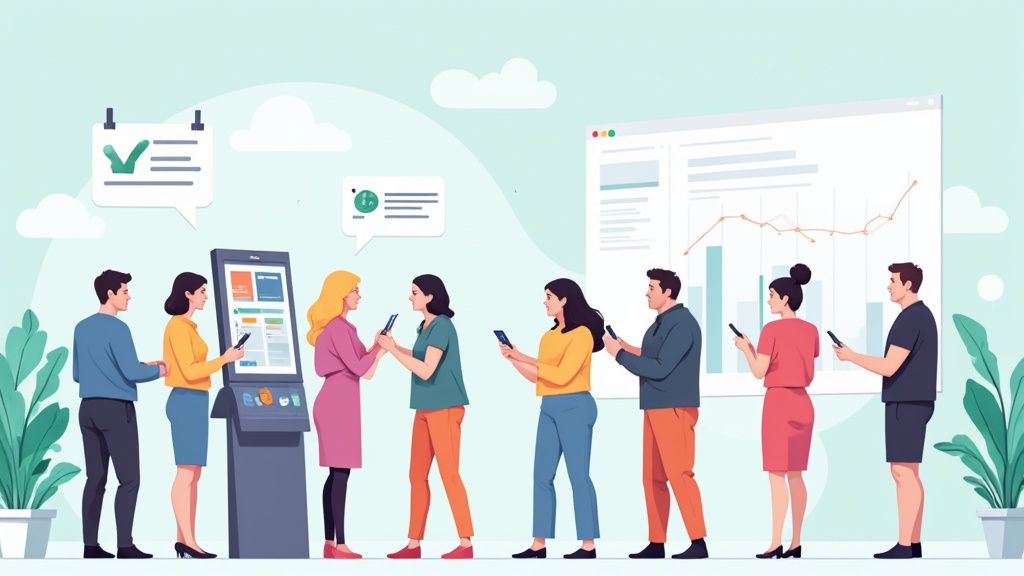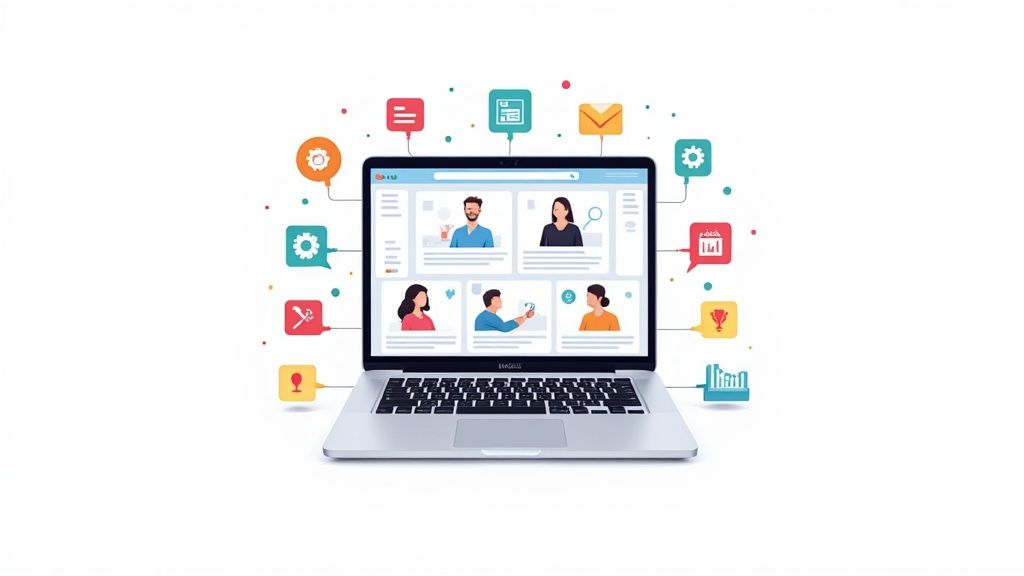Let's be honest: tracking event attendance is about so much more than just getting a headcount. It’s the single best way to measure real engagement, justify your budget, and ultimately prove your event's ROI. When you know who actually walked through the door - not just who clicked "Yes" on an RSVP - you gain powerful data to steer your entire event strategy.
Why Accurate Event Attendance Tracking Matters
Moving past a simple tally of attendees is the strategic heart of successful event management. When you track attendance with precision, you get a crystal-clear picture of your event's true impact on business goals, whether that's growing your sales pipeline or building rock-solid customer loyalty. We’ve seen it time and time again with users of our service: this data is absolutely essential for demonstrating value.
This detailed tracking also leads to much smarter planning for your next event. Did a certain marketing channel bring in the most engaged crowd? Did your VIPs show up in full force? Answering these questions helps you sharpen your approach every single time.
Boosting ROI and Sponsor Value
Having exact attendance numbers gives you concrete proof of your event's reach, which is gold when you're trying to secure and keep sponsors. Remember, they aren't just investing in your brand; they're investing in the audience you bring together.
By giving sponsors verified attendance figures, you're not just selling them booth space - you're offering them access to a qualified, engaged audience. This dramatically increases the perceived value of their investment.
This data-driven approach builds trust and is the foundation for strong, long-term partnerships.
This simple dashboard visualization shows how you can centralize real-time attendance data, moving away from old-school manual counts.
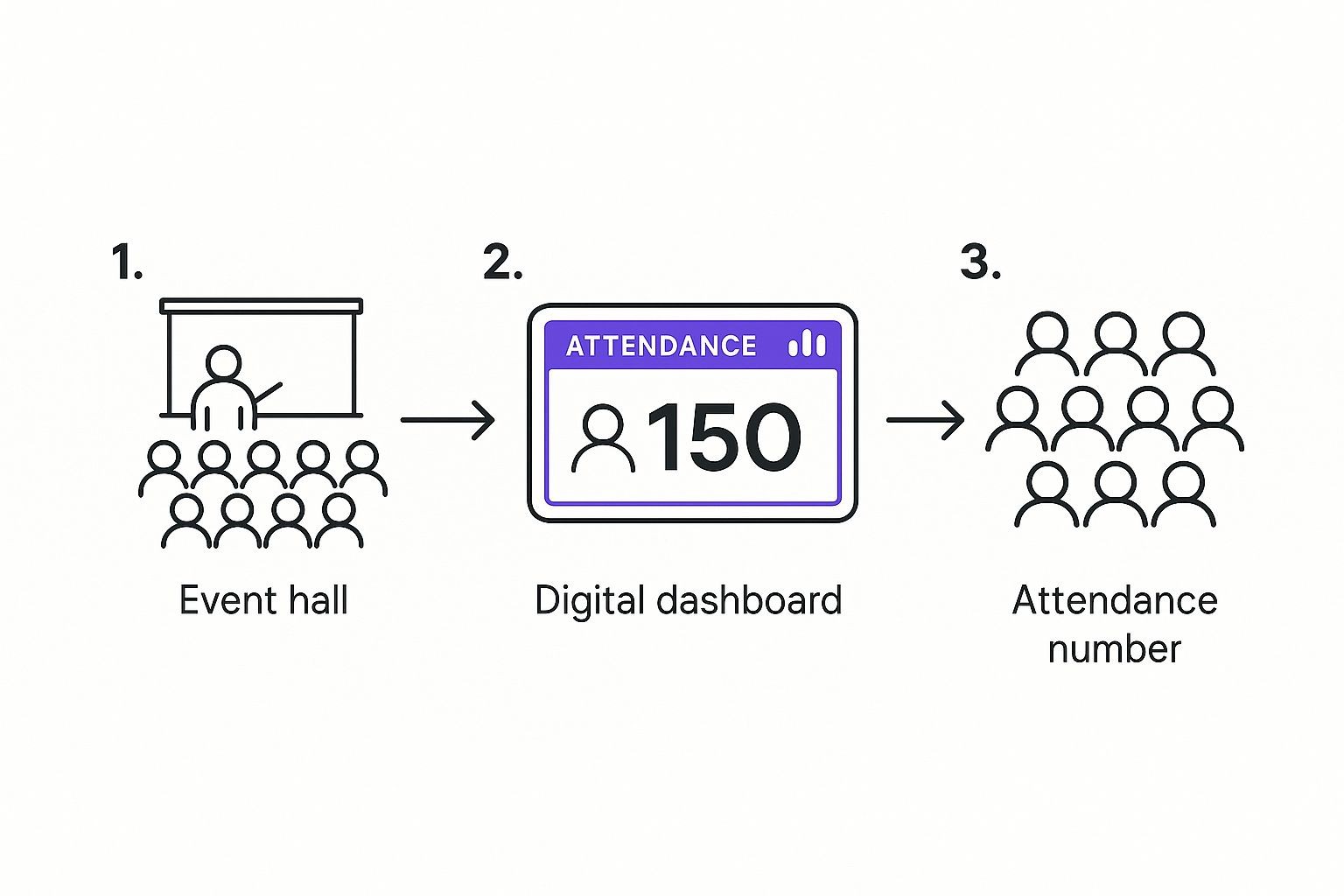
It’s all about shifting from guesswork to automated systems that give you instant, actionable insights.
Enabling Smarter Post-Event Marketing
The importance of this data is only growing. The global events market was valued at a massive $736.8 billion in 2021 and is projected to hit an incredible $2.5 trillion by 2035. To grab a piece of that pie, planners are laser-focused on key goals like pipeline growth (24%) and simply increasing attendance (19%), which makes reliable tracking non-negotiable. You can learn more about the industry's trajectory and what it means for event marketers.
Good tracking also unlocks hyper-personalized follow-up. You can easily create separate communication streams for people who attended versus those who registered but were a no-show.
This lets you:
- Send targeted thank-you notes and feedback surveys to attendees.
- Share event recordings or "sorry we missed you" offers to those who couldn't make it.
- Turn your most engaged attendees into brand advocates with exclusive content or early-bird offers for the next event.
This kind of personalization shows your audience you value their time and participation. It's how you strengthen relationships long after the lights go down.
Setting Up Your Event for Flawless Tracking
Effective event tracking doesn't start on the day of the event. It begins way earlier, with how you set everything up. A few thoughtful minutes spent here can make the difference between a messy spreadsheet of names and genuinely actionable data.
With Add to Calendar PRO, you’re not just creating an event entry; you're building a smart registration and tracking machine. The goal is to automate the whole flow, from the moment someone RSVPs to the second they add it to their calendar. That initial time investment pays off big time, giving you clean, consistent data you can actually use.
Let's walk through how to do this right inside the dashboard.
Customize Your RSVP Form for Richer Data
Sure, "Name" and "Email" are the bare minimum. But the real magic happens when you customize your RSVP form. Think about what you really want to know about your audience. What information would help you follow up more effectively or understand who’s showing up?
You can easily add custom fields to your RSVP form to capture these valuable details.
Here’s a real-world example:
- A B2B tech company running a product webinar might add fields for "Company Name" and "Job Title." This helps them spot high-value leads and see which industries are most interested.
- A community workshop organizer could ask, "How did you hear about us?" to figure out which promotional channels are actually working and which are just wasting money.
The key is to collect information that answers your most important business questions. Don't just add fields because you can; make sure every single one has a clear purpose tied to your event goals.
This simple step transforms a basic registration form into a powerful market research tool. You’re moving beyond just counting heads to understanding your audience on a deeper level.
Generating Your Unique Add to Calendar Links
Once you've dialed in your RSVP form, our service automatically generates the unique 'Add to Calendar' links and buttons. This is the core piece that connects your registration directly to an attendee's personal calendar.
When someone fills out your form, they get a calendar invite that isn't just a generic reminder. It's a piece of data tied directly to their registration.
The integration is completely seamless. You can embed the button right on your website, landing page, or in your email campaigns. Our service handles all the tricky stuff in the background - like generating the right files for Google Calendar, Outlook, and Apple Calendar - so you don't have to.
The most important takeaway? Every click is tracked. This gives you a direct line of sight into who is actively planning to be there.
To get your gears turning, here’s a look at some of the most useful fields you can add to your form and why they're so valuable for tracking.
Essential RSVP Form Fields for Actionable Insights
This table breaks down some of our favorite custom fields. Think of these as a starting point for turning your registration process into a data-gathering powerhouse.
| Field Name | Data Type | Tracking Purpose |
|---|---|---|
| Company Size | Dropdown Menu | Helps you segment your audience. Are you attracting scrappy startups or enterprise-level decision-makers? |
| Primary Goal for Attending | Checkboxes | Gives you direct insight into attendee intent, which is gold for crafting hyper-targeted follow-up messages. |
| Industry | Text Field (or Dropdown) | Allows you to analyze which sectors show the most interest, helping you sharpen future marketing efforts. |
| Referral Source | Dropdown Menu | Directly measures the performance of your marketing channels. Now you'll know exactly where to invest your budget. |
Getting this setup right is the foundation for everything that follows. It ensures every RSVP becomes a valuable data point, giving you the insights you need to measure success accurately and prove your event's ROI.
Managing RSVPs and Communicating Effectively
Getting that RSVP is a great first step, but it’s definitely not the finish line. The real work is turning those positive responses into actual people in seats (or on screens). This all boils down to smart communication and management, which is exactly where our RSVP management dashboard becomes your event command center.
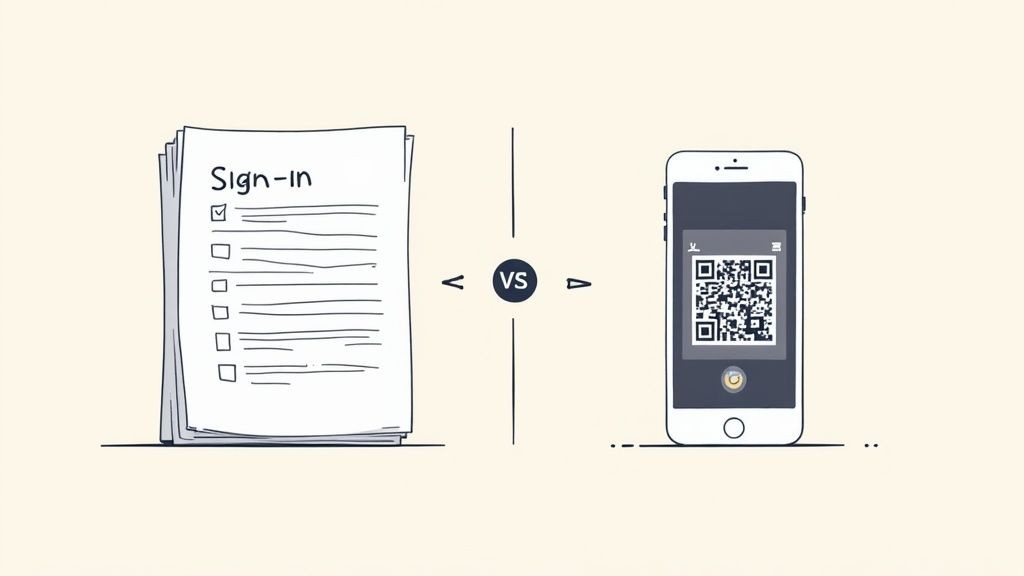
From this dashboard, you can watch every response roll in live. This isn't just some static list; it's a dynamic overview that helps you gauge momentum and make quick decisions. You'll see who has responded, when they did it, and even which calendar service they’re using - small details that help you understand your audience better.
Segment Your Audience for Targeted Messaging
Remember that custom data you collected during the RSVP setup? It's about to become your secret weapon. Instead of blasting generic emails to your entire list, you can slice and dice your registrants for communication that actually connects. This is a total game-changer for keeping people engaged.
For instance, you could:
- Segment by Job Title: Send a special pre-event networking guide exclusively to all the director-level attendees.
- Segment by Interest: If you asked attendees what topics they're most excited about, you can send targeted reminders that spotlight those specific sessions.
- Segment by Referral Source: Offer a small "thank you" discount for your next event to folks who discovered you through a partner's promotion.
This kind of personalization shows you're paying attention and makes your event feel tailor-made for each person. If you're looking for more ideas on this, you can explore different ways to create an RSVP link that captures the exact data you need for smart segmentation.
Based on our experience, consistent, relevant communication is the single biggest factor in maximizing turnout. People are busy, and a well-timed, personalized reminder can be the nudge they need to prioritize your event.
This targeted approach is how you cut through the noise in a crowded inbox.
Automate Reminders That Drive Action
One of the most powerful ways to boost attendance is with automated reminders. By integrating our service with your email marketing platform through Zapier or another automation tool, you can schedule a whole sequence of communications without lifting a finger.
You might want to try a proven reminder schedule like this one:
- One Week Out: Send a "What to Expect" email. This is your chance to highlight key speakers, exciting sessions, or unique networking opportunities.
- Two Days Before: A "Final Details" message. Time to share logistics like parking info, the virtual event link, or the final agenda.
- The Day Before: The classic "See You Tomorrow!" email. Keep it short and energetic to build that last-minute excitement.
These automated touchpoints keep your event top-of-mind and can dramatically reduce your no-show rate. You can even use the dashboard to spot registrants who haven't opened previous emails and send them a special re-engagement message. It’s all about using the data you have to make smarter communication choices and ensure your event is a massive success.
Turning Raw Data into Audience Insights
Collecting RSVPs is one thing. Actually understanding the story that data tells you? That's where the magic happens. This is the moment when tracking event attendance stops being a simple chore and becomes a core part of your strategy. Raw numbers are fine, but turning them into real insights is what fuels growth and sharpens your event marketing.
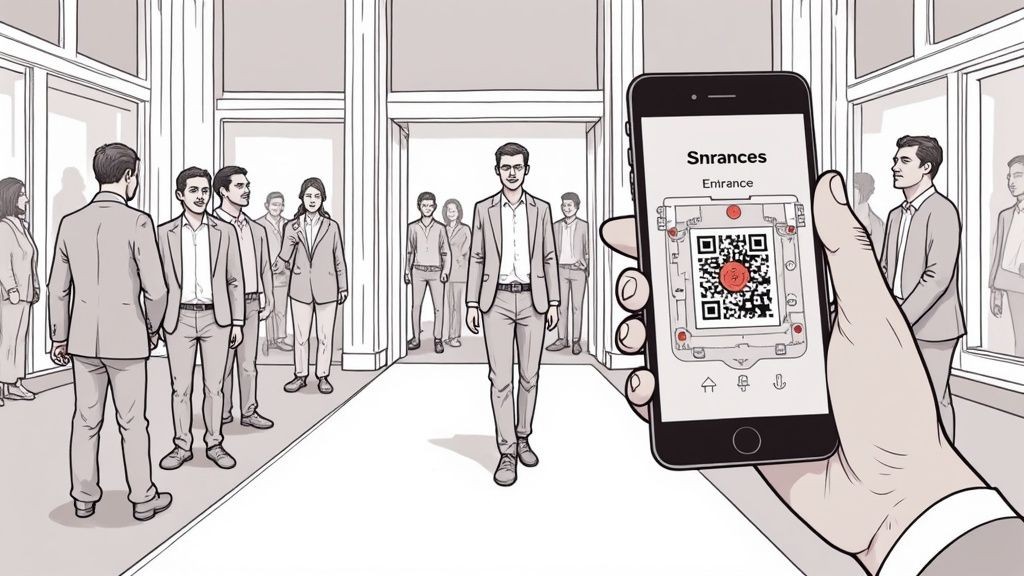
This is exactly what our analytics and reporting features were built for. We help you get past a simple headcount and start digging into the metrics that reveal the truth about your audience and how they find you.
Uncovering Audience Behavior and Preferences
One of the first things you’ll probably notice in our reporting dashboard is the calendar service breakdown. Are your attendees die-hard Google Calendar fans, or do you have a big contingent using Outlook and Apple Calendar? This isn't just a fun fact; it's a direct clue about your audience’s professional world.
Imagine you find out that 80% of your C-suite registrants use Outlook. That's gold. It tells you your executive audience is living in the Microsoft ecosystem, which can guide everything from the file types you share to the tech you prioritize for follow-ups.
Our analytics also show you which of your 'Add to Calendar' links are actually performing. You can drop different links in your emails, on your website, and across social media to see exactly where your sign-ups are coming from.
This helps you answer the real questions:
- Did that LinkedIn campaign actually get people to register, or was it just a bunch of empty clicks?
- Is our website banner outperforming the CTA in our email newsletter?
This kind of detail takes you from "I think this channel works" to "I know this channel brings in X% of my most engaged attendees."
Identifying Trends to Optimize Future Events
The dashboard is also great for spotting trends over time. Do you see a flood of RSVPs two weeks before your event, or does everyone pile in during the last 48 hours? Knowing this registration rhythm is critical for timing your promotional pushes.
If you spot a last-minute rush, you can plan a targeted ad spend or a final reminder email blast for the two days leading up to your next event. You're not guessing anymore; you're riding the natural momentum.
This data-driven approach pulls all the guesswork out of your marketing schedule. You stop just throwing reminders into the void and start deploying them when they’ll make the biggest impact.
For a lot of event organizers, getting the right people in the room is a huge struggle. In fact, a recent study showed that 21% of them say it's their single biggest challenge. And with 71% of professionals using events for both acquiring and retaining customers, you can't afford to get it wrong. It's also worth noting that companies focused on event-based retention are 13% more likely to see major year-over-year growth.
By interpreting these patterns in your own data, you can build a smarter, repeatable playbook for every event you run. This is why our team obsessed over building clear, intuitive reports. To get a complete picture of setting up your systems for success, check out our guide on event attendance tracking for a deeper dive.
Adapting Your Tracking for Virtual and Hybrid Events
The way we run events has completely changed, and our tracking methods have to keep up. The explosion of virtual and hybrid formats presents some new headaches, but it also gives us incredible opportunities to gather super-precise data. The key is to build a strategy that accounts for both your in-person and digital attendees, giving you one clean, unified picture of who actually showed up.
One of the most frustrating parts of virtual events is the "digital no-show." Someone registers with the best intentions, but when the event starts, they can't find the link, forget, or just get distracted. We built our service to tackle this exact problem. By embedding your virtual meeting link (from Zoom, Microsoft Teams, etc.) directly into the calendar event, you remove that last-minute friction. The link is right where they’ll look for it: inside their calendar reminder.
Bridging the Gap Between Registration and Attendance
A truly successful hybrid strategy hinges on connecting two separate pools of data: your registration list and the attendance report from your virtual platform. This is where so many organizers get bogged down, spending hours trying to manually cross-reference spreadsheets after the event is over. There's a much cleaner way.
Think of our RSVP data as your master list for registrations. Once your event is finished, just export the attendance list from your webinar or meeting software. Now you can easily compare it against the RSVP data right from our dashboard.
This simple reconciliation process lets you instantly identify three crucial audience segments:
- Attendees: The folks who RSVP'd and showed up for the virtual session.
- Engaged No-Shows: People who added the event to their calendar but didn't make it. These are warm leads for follow-up!
- Walk-ins: Anyone who joined the event without a formal RSVP (assuming your event settings permit this).
Sorting your audience this way gives you a complete engagement picture, solving a massive headache when it comes to calculating the ROI of your hybrid event.
A Unified View for a Hybrid Audience
This approach provides a single, reliable dataset for your entire audience, no matter how they chose to attend. You're no longer juggling separate silos of information for your in-person and virtual guests. This is absolutely critical as digital events continue their massive growth.
The virtual event market is already on track to hit $236.69 billion and is expected to more than double by 2029. With around 63% of organizers planning to spend more on virtual events, having rock-solid tracking isn't just a nice-to-have; it's essential. You can read the full statistics on the event industry to see just how dominant these formats have become.
The goal is to treat your hybrid event as one cohesive experience, and your data should reflect that. Combining RSVP data with platform analytics gives you that single source of truth needed for accurate reporting and smarter follow-up.
Using this method ensures you can accurately measure engagement, segment your audience for targeted post-event communication, and prove the true reach of your event. For a complete walkthrough of setting this up, you can also check out our guide on online event registration.
Common Questions About Tracking Event Attendance
As you get deeper into tracking your event attendance, you're bound to run into a few questions. It’s a space with a lot of moving parts, and even seasoned event pros hit a snag now and then. We see the same queries pop up all the time, so let's tackle them head-on.
Our goal here is to clear up some of the finer points and help you feel totally confident in your tracking strategy.
What’s the Best Way to Track In-Person Attendance?
For live, in-person events, it’s all about speed and accuracy at the door. While our service, Add to Calendar PRO, is fantastic for wrangling RSVPs before the event, the best approach is to pair that pre-event data with a solid on-site check-in method.
Here are a couple of options that work really well in the real world:
- QR Code Scanning: This is the gold standard for a reason. Generate a unique QR code for every person who registered and use a mobile app to scan them as they arrive. It’s fast, keeps the line moving, and syncs right up with your attendee list.
- Manual Check-in App: A great alternative (or backup) is using a tablet or laptop with a check-in app. Your staff can just pull up the list, find the name, and tap to mark them as "attended."
The key is to export your final RSVP list from our service and pop it right into whatever check-in tool you’re using. This creates a really smooth handoff from online registration to the person walking through your door.
Is It Better to Use a Single Add to Calendar Link or Multiple Ones?
This is a great question, and the answer is almost always to use multiple, unique 'Add to Calendar' links.
Sure, a single link is simple. But it's a black box - it doesn't tell you where your sign-ups are coming from. By creating different links for each of your promotional channels, you unlock some seriously powerful attribution data.
Think about it: you can create one link just for your email newsletter, another for a LinkedIn campaign, and a third for your website's homepage. Our dashboard will then clearly show you which channel is driving the most RSVPs. Suddenly, you have hard data to justify your marketing efforts.
This simple switch turns your attendance tracking from a basic headcount into a real performance marketing tool.
How Do I Handle Walk-Ins or On-Site Registrations?
Walk-ins are just a fact of life for most events. The best way to handle them is with a dedicated station for on-site registration that feeds right into your main attendance list. Most modern check-in apps are built for this and let you add new attendees on the fly.
Once the event is over, you can easily merge that on-site registration list with the pre-event RSVP data from our service. This gives you a complete, accurate count and a full picture of everyone who was there, no matter how they decided to join.
This combined list becomes your single source of truth for all your post-event follow-ups and analysis.
Ready to stop guessing and start tracking your event attendance with precision? With Add to Calendar PRO, you can build a powerful, automated system that turns every RSVP into actionable insight.
